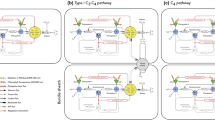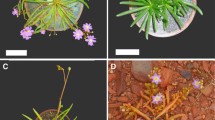Abstract
The potential for C4 photosynthesis was investigated in five C3-C4 intermediate species, one C3 species, and one C4 species in the genus Flaveria, using 14CO2 pulse-12CO2 chase techniques and quantum-yield measurements. All five intermediate species were capable of incorporating 14CO2 into the C4 acids malate and aspartate, following an 8-s pulse. The proportion of 14C label in these C4 products ranged from 50–55% to 20–26% in the C3-C4 intermediates F. floridana Johnston and F. linearis Lag. respectively. All of the intermediate species incorporated as much, or more, 14CO2 into aspartate as into malate. Generally, about 5–15% of the initial label in these species appeared as other organic acids. There was variation in the capacity for C4 photosynthesis among the intermediate species based on the apparent rate of conversion of 14C label from the C4 cycle to the C3 cycle. In intermediate species such as F. pubescens Rydb., F. ramosissima Klatt., and F. floridana we observed a substantial decrease in label of C4-cycle products and an increase in percentage label in C3-cycle products during chase periods with 12CO2, although the rate of change was slower than in the C4 species, F. palmeri. In these C3-C4 intermediates both sucrose and fumarate were predominant products after a 20-min chase period. In the C3-C4 intermediates, F. anomala Robinson and f. linearis we observed no significant decrease in the label of C4-cycle products during a 3-min chase period and a slow turnover during a 20-min chase, indicating a lower level of functional integration between the C4 and C3 cycles in these species, relative to the other intermediates. Although F. cronquistii Powell was previously identified as a C3 species, 7–18% of the initial label was in malate+aspartate. However, only 40–50% of this label was in the C-4 position, indicating C4-acid formation as secondary products of photosynthesis in F. cronquistii. In 21% O2, the absorbed quantum yields for CO2 uptake (in mol CO2·[mol quanta]-1) averaged 0.053 in F. cronquistii (C3), 0.051 in F. trinervia (Spreng.) Mohr (C4), 0.052 in F. ramosissima (C3-C4), 0.051 in F. anomala (C3-C4), 0.050 in F. linearis (C3-C4), 0.046 in F. floridana (C3-C4), and 0.044 in F. pubescens (C3-C4). In 2% O2 an enhancement of the quantum yield was observed in all of the C3-C4 intermediate species, ranging from 21% in F. ramosissima to 43% in F. pubescens. In all intermediates the quantum yields in 2% O2 were intermediate in value to the C3 and C4 species, indicating a co-function of the C3 and C4 cycles in CO2 assimilation. The low quantum-yield values for F. pubescens and F. floridana in 21% O2 presumably reflect an ineffcient transfer of carbon from the C4 to the C3 cycle. The response of the quantum yield to four increasing O2 concentrations (2–35%) showed lower levels of O2 inhibition in the C3-C4 intermediate F. ramosissima, relative to the C3 species. This indicates that the co-function of the C3 and C4 cycles in this intermediate species leads to an increased CO2 concentration at the site of ribulose-1,5-bisphosphate carboxylase/oxygenase and a concomitant decrease in the competitive inhibition by O2.
Similar content being viewed by others
Abbreviations
- PEP:
-
phosphoenolpyruvate
- PGA:
-
3-phosphoglycerate
- RuBP:
-
ribulose-1,5-bisphosphate
References
Apel, P., Maass, I. (1981) Photosynthesis in species of Flaveria. CO2 compensation concentration, O2 influence on photosynthetic gas exchange and δ13 values in species of Flaveria (Asteraceae). Biochem. Physiol. Pflanz. 176, 396–399
Bassüner, B., Keerberg, O., Bauwe, H., Pyarnik, T., Keerberg, H. (1984) Photosynthetic CO2 metabolism in C3-C4 intermediate and C4 species of Flaveria (Asteraceae). Biochem. Physiol. Pflanz. 179, 631–634
Bauwe, H. (1984) Enzyme activities and localization in Flaveria species. Photosynthetic enzyme activities and immunofluorescence studies on the localization of ribulose-1,5-biphosphate carboxylase/oxygenase in leaves of C3-C4 intermediate species of Flaveria (Asteraceae). Biochem. Physiol. Pflanz. 179, 253–268
Edwards, G.E., Huber, S.C. (1981) The C4 pathway. In: The biochemistry of plants — a comprehensive treatise, vol. 8: Photosynthesis pp. 238–282, Hatch, M.D., Boardman, N.K., eds. Academic Press, New York London
Edwards, G.E., Ku, M.S.B., Hatch, M.D. (1982) Photosynthesis in Panicum milioides, a species with reduced photorespiration. Plant Cell Physiol. 23, 1185–1195
Edwards, G., Walker, D.A. (1983) C3, C4: mechanisms, and cellular and environmental regulation of photosynthesis. Blackwell Scientific Publ.
Ehleringer, J., Björkman, O. (1977) Quantum yields for CO2 uptake in C3 and C4 plants. Dependence on temperature, CO2, and O2 concentration. Plant Physiol. 59, 86–90
Ehleringer, J., Pearcy, R.W. (1983) Variation in quantum yield for CO2 uptake among C3 and C4 plants. Plant Physiol. 73, 555–559
Emerson, R., Lewis, C.M. (1941) Carbon dioxide exchange and the measurement of the quantum yield of photosynthesis. Am. J. Bot. 28, 789–804
Farquhar, G.D. (1983) On the nature of carbon isotope discrimination in C4 species. Aust. J. Plant Physiol. 10, 205–226
Farquhar, G.D., von Caemmerer, S. (1982) Modelling of photosynthetic response to environmental conditions. In: Encyclopedia of Plant Physiology, N.S., vol. 12B: Physiological plant ecology, pp. 549–587, Lange, O.L., Nobel, P.S., Osmond, C.B., Ziegler, H., eds. Springer-Verlag, Berlin
Hatch, M.D. (1979) Mechanism of C4 photosynthesis in Chloris gayana: pool sizes and kinetics of 14CO2 into 4-carbon and 3-carbon intermediates. Arch. Biochem. Biophys. 194, 117–127
Hoagland, D.R., Arnon, D.I. (1950) The water-culture method for growing plants without soil. Cal. Agric. Expt. Stat. Circ. No. 347
Holaday, A.S., Chollet, R. (1983) Photosynthetic/photorespiratory carbon metabolism in the C3-C4 intermediate species Moricandia arvensis and Panicum milioides. Plant Physiol. 73, 740–745
Holaday, A.S., Lee, K.W., Chollet, R. (1984) C3-C4 intermediate species in the genus Flaveria: leaf anatomy, ultrastructure, and the effect of O2 on the CO2 compensation concentration. Planta 160, 25–32
Holbrook, G.P., Jordan, D.B., Chollet, R. (1985) Reduced apparent photorespiration by the C3-C4 intermediate species Moricandia arvensis and Panicum milioides. Plant Physiol. 77, 578–583
Ku, M.S.B., Monson, R.K., Littlejohn, R.O., Nakamoto, H., Fisher, D.B., Edwards, G.E. (1983) Photosynthetic characteristics of C3-C4 intermediate Flaveria species. I. Leaf anatomy, photosynthetic responses to O2 and CO2, and activities of key enzymes in the C3 and C4 pathways. Plant Physiol. 71, 944–948
Ku, M.S.B., Edwards, G.E. (1978) Oxygen inhibition of photosynthesis. III. Temperature dependence of quantum yield and its relation to O2/CO2 solubility ratio. Planta 140, 1–6
Küppers, M. (1984) Carbon relations and competition between woody species in a Central European hedgerow. I. Photosynthetic characteristics. Oecologia (Berlin). 64, 332–343
Monson, R.K., Edwards, G.E., Ku, M.S.B. (1984) C3-C4 intermediate photosynthesis in plants. BioScience 34, 563–574
Monson, R.K., Littlejohn, R.O., Williams, G.J. (1982) The quantum yield for CO2 uptake in C3 and C4 grasses. Photosynth. Res. 3, 153–159
Moore, B.d., Ku, M.S.B., Edwards, G.E. (1984) Isolation of leaf bundle sheath protoplasts from C4 dicot species and intracellular localization of selected enzymes. Plant Sci. Lett. 35, 127–138
Reed, J.E., Chollet R. (1985) Immunofluorescent localization of phosphoenolpyruvate carboxylase and ribulose 1,5-bisphophate carboxylase proteins in leaves of C3, C4 and C3-C4 intermediate Flaveria species. Planta 165, 439–445
Rumpho, M.E., Ku, M.S.B., Cheng, S.H., Edwards, G.E. (1984) Photosynthetic characteristics of C3-C4 intermediate Flaveria species. III. Reduction of photorespiration by a limited C4 pathway of photosynthesis in Flaveria ramosissima. Plant Physiol. 75, 993–996
Schürmann, P. (1969) Separation of phosphate esters and algal extracts by thin-layer electrophoresis and chromatography. J. Chromatogr. 39, 507–509
Smith, B.N., Powell, A.M. (1984) C4-like fl-hybrid of C3XC4 Flaveria species, Naturwissenschaften 71, 217–218
von Caemmerer, S., Farquhar, G.D. (1981) Some relationships between the biochemistry of photosynthesis and the gas exchange of leaves. Planta 153, 376–387
Winter, K., Usuda, H., Tsuzuki, M., Schmitt, M., Edwards, G.E., Thomas, R.J., Evert, R.F. (1982) Influence of nitrate and ammonia on photosynthetic characteristics and leaf anatomy of Moricandia arvensis. Plant Physiol. 70, 616–625
Author information
Authors and Affiliations
Rights and permissions
About this article
Cite this article
Monson, R.K., Moore, B.d., Ku, M.S.B. et al. Co-function of C3-and C4-photosynthetic pathways in C3, C4 and C3-C4 intermediate Flaveria species. Planta 168, 493–502 (1986). https://doi.org/10.1007/BF00392268
Received:
Accepted:
Issue Date:
DOI: https://doi.org/10.1007/BF00392268




